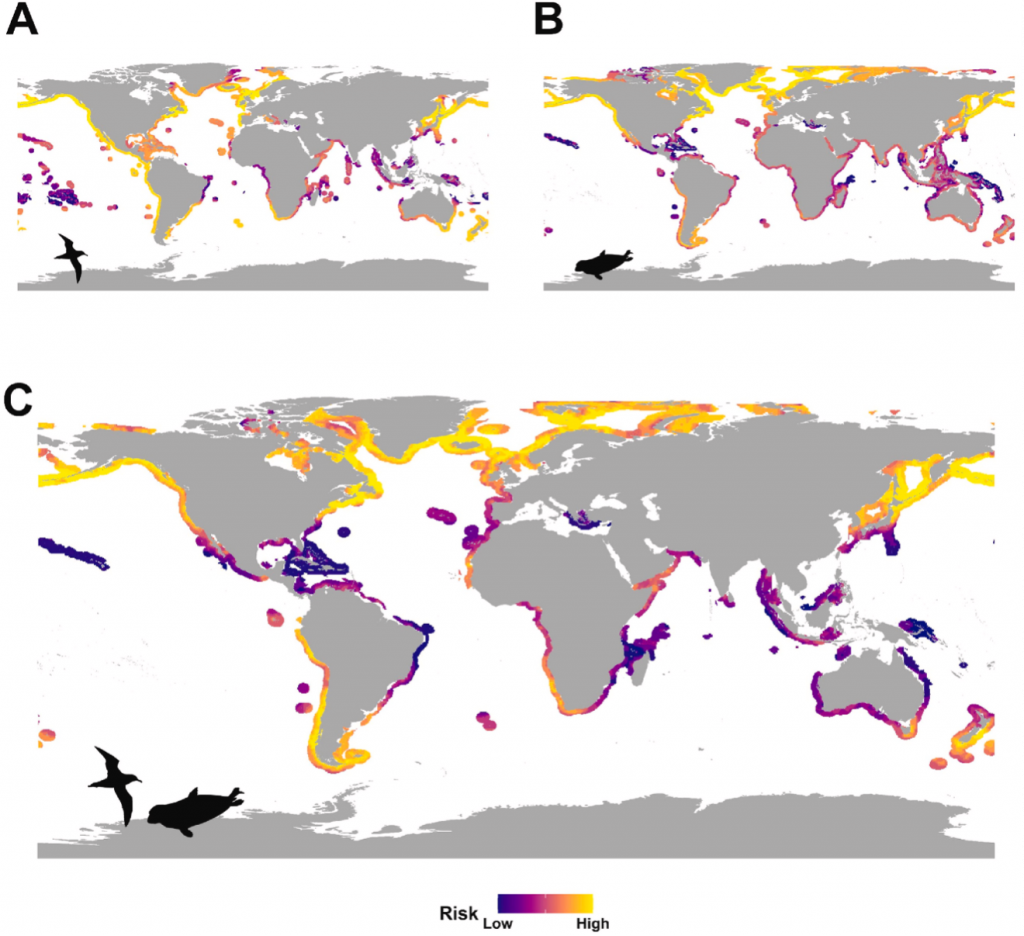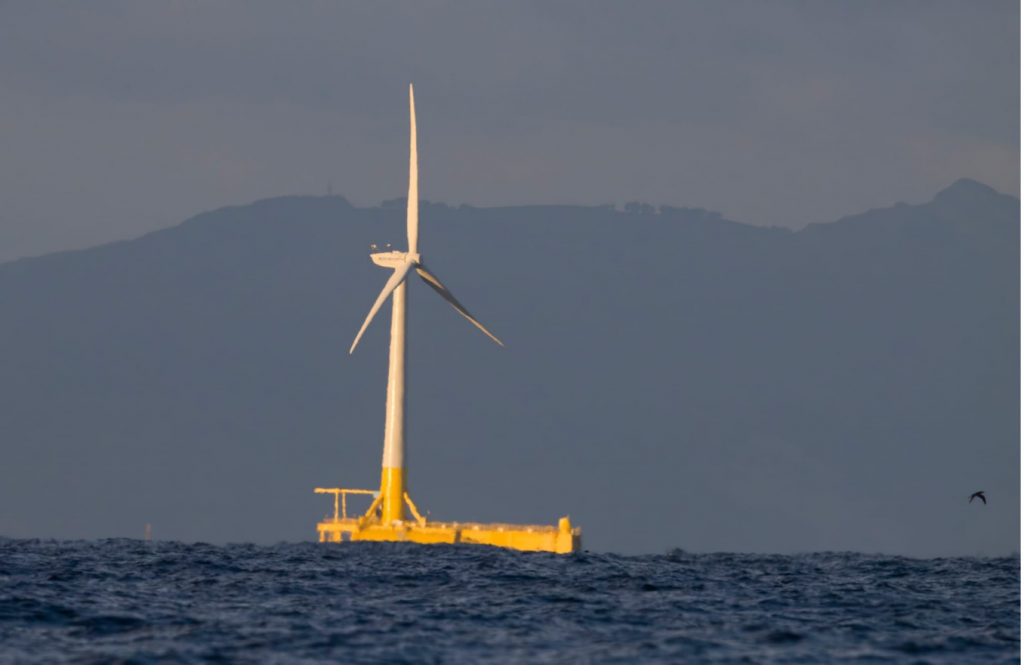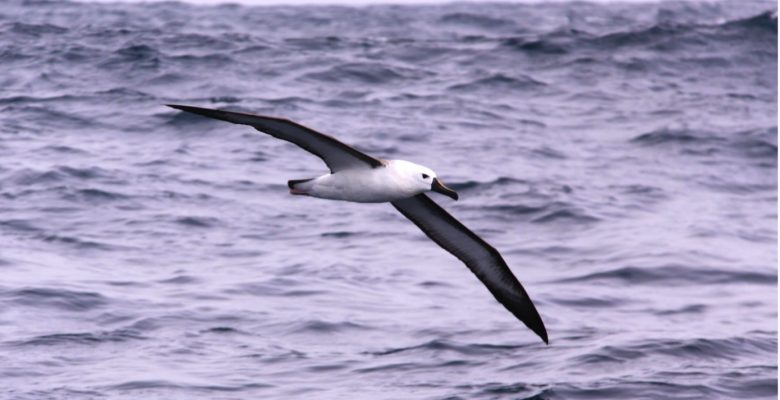As the climate emergency drives the acceleration of offshore wind projects, a major concern is being confirmed: the massive development of this renewable energy often comes at the expense of vital marine ecosystems. A new international study documents the dangerous overlap between key biodiversity areas and those where offshore wind projects are being deployed.
by Laurie Henry
Cover photo: Yellow-nosed albatross (Thalassarche carteri) off the coast of South Africa. This species is one of several seabirds whose feeding grounds may overlap with offshore wind energy development areas. © Juan Manuel Pérez-García
As offshore wind projects multiply in response to the climate emergency, concerns are growing about their impact on marine wildlife. These infrastructures, often installed in areas rich in energy resources, frequently coincide with the feeding grounds of many species of marine mammals and seabirds. A new international study highlights this worrying overlap. For the first time, researchers have created global risk maps, cross-referencing the dynamics of marine food webs with wind energy potential. The objective is clear: to put an end to case-by-case planning and enable a spatial strategy that reconciles climate ambition with the survival of the most vulnerable species.
Rapid and largely unregulated expansion of offshore wind power
Offshore wind power is experiencing spectacular growth worldwide, supported by the climate commitments of many countries. According to data from the Global Wind Energy Council, global installed capacity could reach 380 GW by 2030, compared to 64 GW in 2022. Northern Europe, China and, more recently, the United States account for most of the projects currently underway or planned, and these deployments are part of a drive to accelerate the energy transition in response to the need to rapidly reduce greenhouse gas emissions.
However, this momentum is taking place amid relative uncertainty on the ecological front: at present, few countries have a regulatory framework requiring a detailed assessment of cumulative environmental impacts at sea. Offshore wind farm permits are often issued on a case-by-case basis, without an overall view of the medium- and long-term impacts on marine ecosystems. Offshore installations are rarely assessed once they have been completed, as monitoring them is costly and sometimes technically limited at sea. Furthermore, the available marine biological data is very unevenly distributed.
Some areas with high wind potential, such as the coasts of China and certains parts of Africa, remain poorly understood in terms of biodiversity. This asymmetry of information is such that the risk of installing wind turbines in sensitive areas without knowing it remains high.
A marine ecosystem structured by the food chain: the key to forecasting
To fill this gap and locate critical areas for marine wildlife, Spanish researchers have made a paradigm shift. Instead of focusing on costly and limited monitoring of each animal, they analysed the food resources that attract them. Their model is based on the principle of bottom-up trophic control: the distribution of predators (cetaceans, seabirds) depends directly on the biomass of lower levels (plankton, fish).
Juan Manuel Pérez-García, an ecologist at the UMH, explains that ‘some species consume plankton directly, while others depend on fish that feed on it’. This configuration makes it possible to predict, based on global data on marine productivity, the areas where higher species gather to feed.
By cross-referencing these predictions of high biological concentration with areas of high wind potential, scientists have been able to obtain an accurate reading of potential conflicts. These data not only describe the distribution of fauna, but also reveal the global ecological mechanisms that make certain areas vital for biodiversity. Species with limited ranges, whose feeding areas are few and far between, appear to be the most vulnerable.

Regions of the world where offshore wind development projects overlap with likely feeding areas for seabirds with restricted ranges (A), marine mammals (B), and both groups combined (C). The brighter the colour, the higher the potential risk to wildlife. © Morant et al., 2025
Multiple effects, from noise to changes in trajectory
The installation of offshore wind turbines profoundly alters the marine environment, with consequences that are not all visible in the short term. Among the direct negative effects is the risk of collision for seabirds, particularly during migration periods. Underwater noise pollution, generated in particular by pile driving during construction, disrupts communication, navigation and feeding for marine mammals such as dolphins and whales.
Other more indirect impacts are equally worrying. The presence of massive structures alters local currents and the ecology of the seabed, causing a cascade of effects on food chains. Conversely, some sites can become temporary refuges, and the ban on fishing in areas occupied by wind farms sometimes has a sanctuary effect. However, this ‘ecological break’ is not always enough to compensate for the disturbances created.

Offshore wind turbine © Iñigo Zuberogoitia Arroyo
Certain avoidance or adaptation behaviours have also been observed. GPS tracking shows that some species of seabirds alter their flight paths to avoid wind farms, which increases their flight time and reduces their feeding efficiency, causing significant energy stress. Ongoing research on cetaceans is also seeking to determine whether their hunting behaviour is disrupted by the installation of offshore wind turbines.
Better integrating biodiversity into energy planning
Faced with these threats, the authors of the study call for urgent and far-reaching reform of maritime spatial planning. While many wind farm projects are designed before their impact on local biodiversity has even been assessed, the evidence today is clear: risk maps show that areas of very high ecological value remain outside the boundaries of marine protected areas (MPAs), limiting the ability of these MPAs to mitigate the effects of industrial projects on marine biodiversity.
Risk maps reveal a marked overlap between areas with high wind energy potential and identified feeding grounds for seabirds and marine mammals. This coincidence is particularly strong in the Northern Hemisphere, notably in the North Sea, the Barents Sea, the North American Atlantic coast and part of the north-western Pacific. Conversely, some regions in the Southern Hemisphere show much less overlap, a difference that the authors attribute in part to a lack of biological data rather than an actual absence of risk. The species most affected are those with limited ranges, whose feeding areas are few in number and therefore more vulnerable.
The researchers are calling for a targeted expansion of these protected areas and the creation of strict exclusion zones where the installation of energy structures would be strictly prohibited. These zones should be defined on the basis of independent scientific data, which should be regularly updated. ‘It’s not about blocking wind power, but about directing it to where it will have the least impact,’ insists Pérez-García.
The use of technological monitoring tools, such as GPS tracking, to identify the routes and feeding habits of species should make it possible to identify the ecological corridors that need to be preserved. Finally, the authors stress the need for proactive governance. Training public actors to interpret this complex data should ensure that the energy transition is carried out with a solid scientific culture. The challenge is not only technical, but also institutional if we want to make energy clean and compatible with marine life.
Source : Jon Morant et al., “Potential feeding sites for seabirds and marine mammals reveal large overlap with offshore wind energy development worldwide”. Journal of Environmental Management (2024).
